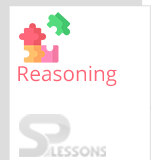 Introduction
Introduction
Reasoning is an important section in the employment related competitive exams in India. In particular, exams like RRB, SSC, IES, IAS, UPSC, IBPS, SBI, SIB, Insurance, IDBI and other bank related employment exams have Reasoning questions along with Quantitative Aptitude. The Reasoning section primarily has questions related to the Syllogism, Directions, and Inequality , etc. This article presents SSC Selection Post Phase-VII Reasoning Ability Quiz 2 for acing the SSC Selection Post Phase-VII Reasoning Ability Examination.
 Quiz
Quiz
Direction(1-3): Each of the following questions consists of two sets of figures. Figures A, B, C and D constitute the Problem Set while figures 1, 2, 3, 4 and 5 constitute the Answer Set. There is a definite relationship between figures A and B. Establish a similar relationship between figures C and D by selecting a suitable figure from the Answer Set that would replace the question mark (?) in fig. (D).
1. Select a suitable figure from the Answer Figures that would replace the question mark (?).
Problem Figures:
- A. 1
B. 2
C. 3
D. 4
- A. 1
B. 2
C. 3
D. 4
- A. 1
B. 2
C. 3
D. 5
- A. 11 5
B. 10 7
C. 11 8
D. 5 10
- A. 25 18
B. 25 21
C. 25 29
D. 24 21
Direction(1-2): In each of the following questions, find out which of the answer figures (1), (2), (3) and (4) completes the figure matrix ?
1. Select a suitable figure from the four alternatives that would complete the figure matrix.
- A. 1
B. 2
C. 3
D. 4
- A. 1
B. 2
C. 3
D. 4
- A. 1
B. 2
C. 3
D. 4
- A. 1
B. 2
C. 3
D. 4
- A. 1
B. 2
C. 3
D. 4
Direction(1-3): Study the information below and answer the following question: –
In a certain code language,
‘CUT DAFTLY FUN EARSH’ is written as “&23T, $31Y, *17N, #13H”
‘CAW DOLL FLIGHT ENMEW’ is written as “&26W, $16L, *26T, #28W”
‘CON DEERS FEAR EMETIN’ is written as “&17N, $24S, *22R, #20N”
‘FLIPPY CAR EASER EGG’ is written as “*31Y, &21R, #23R, #10G”
1. Which of the following is the code for “FAIR”?
- A. *22R
B. *13R
C. #15R
D. $13R
- A. C
B. D
C. E
D. F
- A. Egg
B. Eagle
C. Elephant
D. Edit
- A.
B.
C.
D.
- A. Teacher
B. President
C. Doctrine
D. Prisoner


















